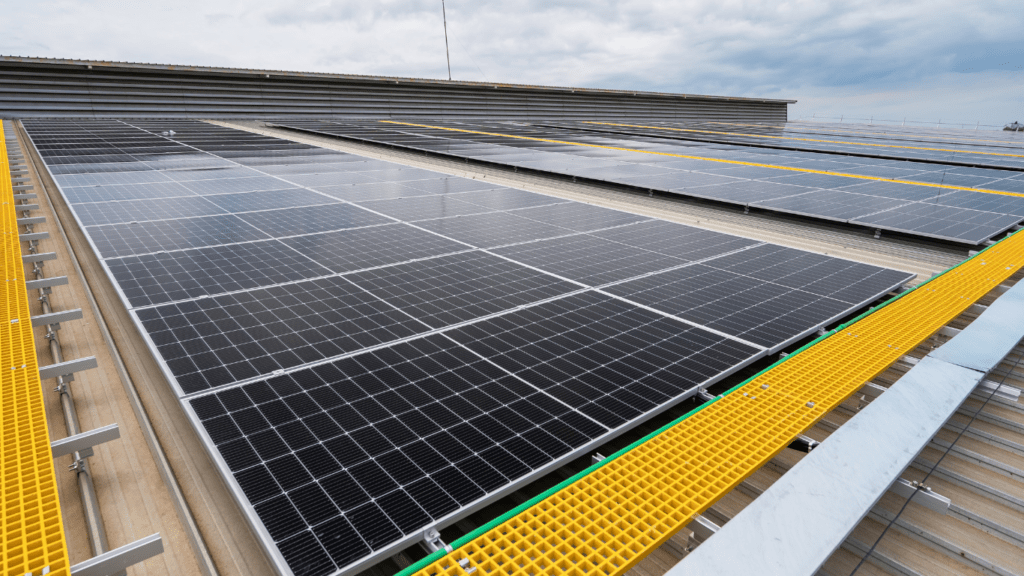Emerging Trends in Next-Generation Renewable Energy Solutions
The Rise of Solar Power Enhancements
Advanced solar power technologies promise to change the energy landscape significantly. Photovoltaic (PV) cells, for instance, are now more efficient and cost-effective than ever.
Researchers have focused on improving the efficiency of PV cells by using perovskite materials, which could surpass traditional silicon-based cells.
I find it fascinating that perovskite cells can reach efficiency rates exceeding 25%, based on studies from the National Renewable Energy Laboratory.
Another emerging trend in solar energy is the integration of solar panels with energy storage systems.
Lithium-ion batteries are leading this space, helping solar solutions maintain a consistent energy supply even when sunlight is unavailable.
Companies like:
- Tesla
- LG Chem
are spearheading these advancements, making solar energy a more viable option for both residential and commercial use.
Solar panels with bifacial designs, capturing sunlight from both sides, are another noteworthy innovation.
These panels can increase energy yield by up to 30% compared to traditional single-sided panels.
This technology is particularly useful in areas with reflective surfaces, like snowy regions or sandy deserts.
Innovations in Wind Energy Technology
- Wind energy technology is also undergoing significant transformations. One development that stands out is the creation of larger and more efficient wind turbines.
- Modern turbines, often exceeding 100 meters in height, generate more electricity and are better suited for offshore installations.
- According to the Global Wind Energy Council, these turbines can produce up to 12 MW per unit, making them incredibly efficient.
- Offshore wind farms are gaining traction, leveraging powerful and consistent winds over oceans to generate electricity. Floating wind turbines enable installations in deeper waters where winds are even stronger
- Pioneers like Equinor and Siemens Gamesa are leading these advancements, pushing the boundaries of where wind energy can be deployed.
- Another trend is the use of artificial intelligence (AI) and machine learning (ML) in wind farm management.
- AI algorithms optimize energy output by adjusting turbine settings in real-time based on wind conditions.
- Companies like General Electric (GE) are implementing these technologies to maximize efficiency and reduce maintenance costs.
- Energy storage solutions tailored for wind energy are also emerging. By storing excess energy produced during peak wind periods, these systems ensure a continuous power supply.
- Integrating wind farms with batteries or other storage technologies enhances the reliability of wind-generated electricity.
These emerging trends in next-generation renewable energy solutions showcase an exciting future powered by cutting-edge solar and wind technologies capable of transforming our approach to sustainable energy.
Advancements in Bioenergy and Geothermal Systems
Breakthroughs in Biofuel Production
Innovative methods in biofuel production increase efficiency and reduce costs. Advanced enzymatic hydrolysis techniques convert biomass into biofuel more effectively than traditional methods.
For instance, companies like Novozymes have developed enzymes that enhance the breakdown of plant materials by up to 30%.
Algal biofuel gains traction as a high-yield energy source, with its production doubling every 24 hours under optimal conditions.
According to the U.S. Department of Energy, algae can produce up to 5,000 gallons of biofuel per acre per year.
Furthermore, integrating genetic engineering into biofuel crops like switchgrass increases their energy output and reduces growth time.
Developments in Geothermal Heating and Cooling
Geothermal systems capitalize on earth’s consistent subsurface temperatures for heating and cooling.
Enhanced Geothermal Systems (EGS) drill deeper to access geothermal energy, expanding potential installation locations.
The U.S. Geological Survey estimates that EGS could supply over 100 gigawatts (GW) of electric power in the U.S. alone.
Advanced binary cycle power plants improve efficiency and reduce emissions by using organic fluids with low boiling points.
The International Renewable Energy Agency notes that these plants can achieve efficiency rates close to 15%, a significant improvement over traditional geothermal plants.
Additionally, direct use geothermal applications—like district heating and greenhouse climate control—cut energy costs and reduce reliance on fossil fuels.
Integration of Renewable Energy into Existing Grids
Smart Grids and Energy Storage Solutions
Smart grids use advanced technologies for better efficiency and reliability in electricity distribution. They integrate renewable energy sources like wind and solar, ensuring a balanced power supply. Smart grids improve energy management by utilizing real-time data, allowing operators to predict and respond to energy demand changes.
Energy storage solutions are crucial for handling fluctuations in renewable energy generation. Technologies like lithium-ion batteries, flow batteries, and pumped hydro storage store excess energy, then release it when production dips. These systems ensure grid stability and smooth out supply inconsistencies.
Challenges and Solutions for Grid Integration
Integrating renewable energy into existing grids comes with several challenges.
The intermittent nature of sources like solar and wind leads to unpredictability in power generation. This issue requires solutions like advanced forecasting techniques and grid flexibility measures.
Another challenge is maintaining grid stability and reliability.
Enhanced grid infrastructure, such as high-voltage direct current (HVDC) transmission lines and upgraded substations, is essential.
By improving these components, grids can handle the increased load from renewable sources.
Additionally, regulatory policies play a significant role in facilitating grid integration.
Clear standards and incentives encourage investments in renewable energy and smart grid technologies.
Collaboration between governments, utility companies, and technology providers ensures the successful transition to a greener grid.
Impact on Environmental Sustainability

Reduction in Carbon Footprints
Next-generation renewable energy solutions play a significant role in reducing carbon footprints.
Technologies like:
- solar panels
- wind turbines
produce electricity without releasing CO2.
These renewable sources directly displace fossil fuels, lowering greenhouse gas emissions.
For example, a typical coal-fired power plant emits about 2.2 pounds of CO2 per kWh, while solar and wind systems emit none during operation.
According to the International Renewable Energy Agency (IRENA), renewable energy adoption helped reduce global CO2 emissions by over 2 gigatons in 2020.
Energy-efficient smart grids also contribute to carbon reduction. By optimizing energy distribution and reducing waste, smart grids ensure maximum utilization of renewable energy.
Incorporating energy storage systems such as lithium-ion batteries further minimizes CO2 emissions by storing excess energy and releasing it when demand is high, thus avoiding the need to ramp up fossil fuel-based power generation.
Promotion of Biodiversity and Ecosystem Health
Renewable energy developments support biodiversity and ecosystem health. Wind farms, for instance, can coexist with agricultural activities, allowing dual land use.
This minimizes habitat disruption and promotes biodiversity. Solar farms can integrate with pollinator-friendly habitats, which boost local ecosystems.
Biofuels made from organic waste materials reduce the need for deforestation linked to biofuel crops.
This sustainable practice preserves natural habitats and protects species.
Geothermal energy, with its low land footprint, causes minimal disruption to local ecosystems compared to conventional energy projects.
Next-gen renewable projects also incorporate environmental assessments to mitigate impacts.
For instance, offshore wind farms are designed to avoid critical marine habitats, ensuring minimal interference with marine life.
By integrating renewable energy solutions thoughtfully, we can promote environmental sustainability while supporting diverse ecosystems.

